10-Year Commitment to Global Health and Rights: Annual Report for 2020-2021
ISSN 2817-2159
This report reviews the first year of implementation of the Government of Canada’s 10-year commitment to global health and rights (10YC). It focuses on our spending, policy and programming efforts from April 1, 2020 to March 31, 2021.
On this page
- Executive summary
- Introduction
- 10YC fiscal year 2020–2021 in review
- 10YC portfolio analysis
- Performance, transparency, engagement and learning
- Looking forward
Executive summary
This report reviews the Government of Canada (GOC)’s first year of implementation of the 10-year commitment to global health and rights (10YC). It focuses on our spending, policy and programming efforts from April 1, 2020 to March 31, 2021.
Highlights include:
- $1.22 billion was disbursed towards the 10YC with $730 million for global health and nutrition and $489 million for SRHR.
- Nearly $104 million was invested in the four SRHR neglected areas—an increase of $13 million from the previous fiscal year (2019–2020).
- The three largest sectoral investments in the 10YC portfolio were:
- sexually transmitted disease (STD) control including HIV/AIDS (12.3%)
- infectious disease control (9.8%)
- reproductive healthcare (8%)
- The 10YC was implemented through 425 projects in partnership with 202 organizations, including:
- multilateral organizations (69.6%);
- civil society organizations (CSOs) (25%);
- governments (5.4%);
- private sector actors (0.02%).
- CSOs played a particularly important role for the SRHR commitment, serving as implementing partners for 28% of the our overall global SRHR programming.
- Internally, Global Affairs Canada (GAC) strengthened its coding guidance and training for staff to ensure that 10YC programming was coded in line with the Organization for Economic Cooperation and Development (OECD) DAC Sector Codes. GAC also developed new sector codes to specifically track investments in the SRHR neglected areas.
- In addition, GAC successfully piloted a new approach to collect Key Performance Indicator (KPI) data to strengthen accountability towards achievement of the 10YC.
Looking forward, Canada will continue to scale up gender-transformative investments in global health, nutrition and SRHR to meet the $1.4 billion target by fiscal year 2023–2024. As part of the 10YC, we will also increase investments in the SRHR neglected areas. In addition, we will continue to demonstrate leadership and advocate for global health, nutrition and SRHR for the most marginalised, especially women, girls and adolescents.
Introduction
In June 2019, the Government of Canada (GoC) made a 10-year commitment (2020-2021 to 2029-2030) to increase funding to reach an average of $1.4 billion annually by 2023, to advance the health and rights of women and girls around the world. This historic investment is known as the 10-year commitment to global health and rights (10YC). The 10YC specifically pledges an allocation of $700 million a year for sexual and reproductive health and rights (SRHR) with a particular focus on scaling up investments in neglected, or under-funded areas of SRHR:
- safe abortion and post-abortion care
- comprehensive sexuality education (CSE)
- family planning and contraception
- SRHR advocacy
The 10YC is a key vehicle for implementing Canada’s Feminist International Assistance Policy (FIAP) and supporting the achievement of the 2030 Agenda for Sustainable Development.Footnote 1 The 10YC’s two $700 million pillars of i) health and nutrition; and ii) a comprehensive approach to SRHR are mutually reinforcing. Our 10YC funding is primarily channelled from Global Affairs Canada’s (GAC) International Assistance envelope and Canada’s contributions to International Financial Institutions.
The 10YC is accompanied by an accountability framework developed in consultation with global health stakeholders, including Canadian civil society partners and academic institutions. The framework helps to:
- track and deliver information on spending
- monitor performance and evaluate results
- ensure transparency, engagement and learning
The 10YC builds on Canada’s leadership on health, nutrition, gender equality and SRHR. It follows three important Canadian initiatives for maternal, newborn and child health (MNCH) and SRHR:
- the $2.85 billion Muskoka Initiative for MNCH from 2010 to 2015
- the $3.5 billion renewed MNCH Initiative from 2016 to 2020
- the $650 million Her Voice, Her Choice Commitment from 2017 to 2020
In March 2020, Canada fulfilled these three commitments representing more than a decade of leadership in global health and rights.
The 10YC focuses its efforts on the FIAP three-paths to action:
- increase quality and accessibility of health services
- improved gender-sensitive nutrition
- increase access to SRHR, especially to the neglected areas
This report reviews Canada’s first year of implementation of the 10YC. It focuses on our spending, policy and programming efforts from April 1, 2020 to March 31, 2021.
The implementation of the 10YC began in April 2020, at the same time as the start of the global COVID-19 pandemic. During this period of increased critical health needs, mobility restrictions and associated lockdowns, we responded swiftly to the COVID-19 crisis. A significant portion of Global Affairs Canada’s COVID-19 International Assistance response was delivered through one-time, additional funding to the department, separate from the 10YC funding. The department disbursed close to $1.97 billion for the global response to COVID-19 in fiscal year 2020-2021 (between April 1, 2020 to March 31, 2021). This included:
- $865 millionfor the ACT-Accelerator
- $739 million in humanitarian and development assistance
- adapted funding arrangements with organizations to address COVID-19 needs worth over $370 million.
10YC fiscal year 2020-2021 in review
In fiscal year 2020–2021 (April 1, 2020 to March 31, 2021), Canada disbursed a total of $1.22 billion under the 10YC. This includes $730 million for global health and $489 million for SRHR investments. These funding amounts were a noticeable increase from previous years (see chart).
Global health and SRHR spending FY2017-2018 to FY2023-2024:
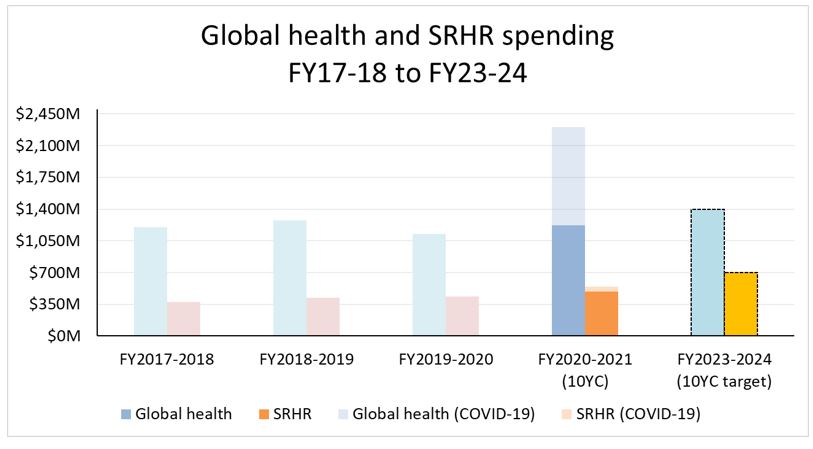
Text version
- 2017–2018
- Global health: $1,202M
- SRHR: $372M
- 2018–2019
- Global health: $1,277M
- SRHR: $421M
- 2019–2020
- Global health: $1,125M
- SRHR: $439M
- 2020–2021 (10YC)
- Global health: $1,219M
- SRHR: $489M
- Global health (including additional COVID-19 response funding): $2,306M
- SRHR (including additional COVID-19 response funding): $543M
- 2023–2024 (10YC target)
- Global health: $1,400M
- SRHR: $700M
COVID-19 international assistance response
As noted, in fiscal year 2020-2021, Global Affairs Canada received additional, one-time financing to support our international response to COVID-19. This funding raised our total health-related disbursements close to $2.31 billion, including $1.76 billion and $543 million for global health and SRHR investments, respectively. The one-time, additional funding was allocated from the fiscal framework (including as part of Budget 2021), the Prime Minister’s Strategic Priorities Fund, the Strategic International Vaccines Envelope (managed by Public Health Agency of Canada (PHAC)), and the Crisis Pool. It worked to strengthen global coordinated action against COVID-19 through global health platforms such as the Global Fund to Fight AIDS, Tuberculosis and Malaria (GFATM) ($65 million) and Gavi, The Vaccine Alliance ($295 million), among others. In addition, to elevate women's and girls' voices and engage women's rights organizations (WROs), Global Affairs Canada provided COVID-19 top-up funding under the Women’s Voice and Leadership Initiative. This funding reached 300 WROs around the world and ensured their survival during the challenging times of the pandemic.
Global health
The 10YC builds on our ongoing global health and nutrition investments, and on our leadership rooted in the Feminist International Assistance Policy’s Health and Nutrition Action Area policy. The 10YC supports a wide range of partners, including international global health organizations, multilateral institutions and Canadian and international CSOs to help the poorest and most vulnerable.
In fiscal year 2020–2021, Global Affairs Canada disbursed $1.22 billion under the 10YC for global health programming. This funding includes support to the following global health platforms:
- the GFATM
- Gavi, the Vaccine Alliance
- the Global Polio Eradication Initiative (GPEI)
- the Global Financing Facility for Women, Children and Adolescents (GFF)
Canada’s investments in global health platforms cover a number of priorities under the FIAP Health and Nutrition Action Area Policy. Our engagement helps to directly support health services, nutrition, SRHR and gender equality policies and programming and capitalizes on opportunities for integration. For example, Canada’s $600 million pledge to Gavi’s 2021–2025 strategy supports immunization programs, including those that integrate sexual and reproductive health (SRH) services. Global health investments also contribute to improving the effectiveness of our international assistance. For instance, our investments in GFATM and the GFF support innovative programming. Canada’s board membership roles in global health organizations and platforms allow us to contribute to strengthening organizational effectiveness and promote coordination with other development actors to maximize the impact of our contributions.
Nutrition
With respect to nutrition, Canada invests roughly $90 million annually in nutrition-specificFootnote 2 programming as part of the 10YC. We integrate our nutrition programming within the sectors of health, education and agriculture, with a cross-cutting focus on gender. Our nutrition partnerships include, for example, those with the World Food Programme to support nutritious school meals, and with Global Nutrition Report and Standing Together for Nutrition to support relevant research. We also maintain a longstanding partnership with Nutrition International, contributing approximately $50 million per year. In 2020-2021, our support to Nutrition International contributed to reaching 272,652 girls with weekly iron and folic-acid supplements, and 148,750 women with iron and folic-acid supplements during pregnancy.
SRHR – Highlights of Canada’s support for neglected SRHR areas
A priority of the 10YC is to increase investments in four neglected SRHR programming areas:
- safe abortion and post-abortion care
- comprehensive sexuality education (CSE)
- family planning and contraception
- SRHR advocacy
The prevention of sexual and gender-based violence (SGBV) is also a priority area for Canada. All SGBV programming investments (excluding humanitarian) count towards the 10YC.
Canada’s approach to SRHR is based on a comprehensive definition of SRHR, guided by the Guttmacher-Lancet Commission. Supporting comprehensive SRHR means enabling all individuals to have the rights, knowledge, and means to make decisions and access services concerning their reproductive lives and sexuality, free from criminalization, coercion, discrimination and violence.
As part of the 10YC accountability framework, for the first time, Global Affairs Canada established an investment baseline in the four SRHR neglected areas. This was done by using new SRHR sub-sector codes that GAC developed. In fiscal year 2020–2021, close to $104 million was directed to the four SRHR neglected areas, an increase of $13 million from fiscal year 2019-2020. The following sections provide a deeper look at progress across the four neglected areas.
SRHR neglected areas in FY2019-2020 & FY2020-2021
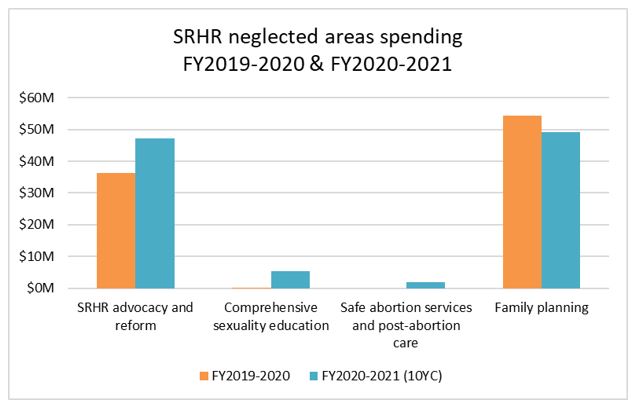
Text version
- 2019–2020
- SRHR Advocacy and Reform: $36.2M
- Comprehensive Sexuality Education: $0.2M
- Safe Abortion Services and Post-abortion case: $0
- Family Planning: $54.3M
- 2020–2021
- SRHR Advocacy and Reform: $47.3M
- Comprehensive Sexuality Education: $5.4M
- Safe Abortion Services and Post-abortion case: $1.9M
- Family Planning: $49.1M
SRHR neglected area 1: SRHR advocacy and reform
SRHR advocacy is the process of deliberately seeking to influence and change the laws, policies and actions of governments, international institutions and the private sector to achieve positive changes in SRHR. It also seeks to shift unequal power relations and influence societal and cultural norms through behavioural change that positively impacts gender equality and the empowerment of women, girls and other marginalized populations. In fiscal year 2020–2021 GAC invested $47.3 million in this area. The chart “SRHR Advocacy and Reform FY20–21 ($)” shows the breakdown of this investment by GAC programming branch, including Global Issues and Development (multilateral programming), and Partnerships for Development and Innovation (Canadian partnerships).
During the first year of the COVID-19 pandemic, SRHR advocacy was particularly important. Disruptions in access to essential health services, including access to SRH services, and essential maternal health-care services, due to the diversion of resources to respond to the COVID-19 pandemic, created a direct risk to the health of women and girls. GAC-funded advocacy efforts were intended to minimize the diversion of financial resources and to protect adolescents’ and women’s health, empowerment and SRHR.
SRHR advocacy and reform FY2020-2021
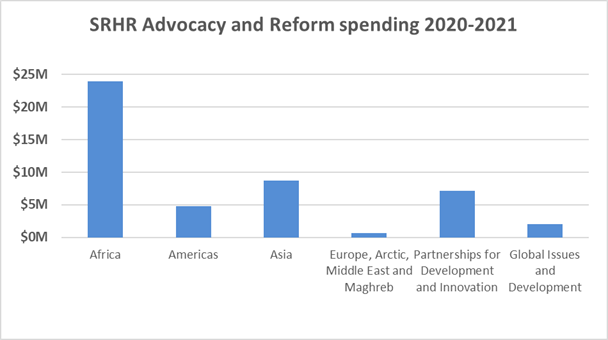
Text version
- Europe, Arctic, Middle East and Maghreb: $0.7M
- Partnerships for Development and Innovation: $7.2M
- Global Issues and Development: $2.1M
- Americas: $4.8M
- Asia: $8.7M
- Africa: $24.0M
Canada works to advance SRHR advocacy with global partners and initiatives like SheDecides, the United Nations Population Fund (UNFPA), the Global Safe Abortion Dialogue, the GFF, the GFATM and Family Planning 2030 (FP2030). We also work closely with other bilateral donors such as the United Kingdom, the Netherlands, Sweden and Norway, including through the Nexus Initiative, which brings like-minded donors together to advocate and speak with a common voice for SRHR during international negotiations at UN forums. We have been a member of the Nexus Initiative since July 2019, and played an active role in its Coordinating Committee in 2020 and 2021. Through this Initiative, we have worked alongside like-minded countries to support, protect and advance strong SRHR and gender-equality in multilateral negotiations. As a SheDecides Champion, Canadian Ministers of International Development advocate alongside other global leaders, including youth, to communicate, inform and expand on the SheDecides movement’s rights-based comprehensive SRHR priorities and approach. The movement brings together a diverse group of leaders and activists including a strong youth voice, to connect, to shift power and to challenge norms, and to stand up and act.
Canada is also proud to be part of the Generation Equality Forum, including as a Commitment Maker to the Action Coalition on Bodily Autonomy and SRHR. We engage with a dynamic, multi-stakeholder set of actors jointly dedicated to advancing SRHR priorities around the world.
Key advocacy moment in fiscal year 2020–2021 included:
- SRHR roundtable with the President of the National Institute for Women of Mexico and other Latin American Ministers
- keynote address on International Human Rights Day with the International Planned Parenthood Federation (IPPF) on how intersectionality impacts SRHR
- co-hosted the UNFPA Supplies Global Partnership Launch event and announced $39 million in new funding for UNFPA Supplies to help protect access to family-planning services and commodities during the pandemic.
SRHR neglected area 2: Comprehensive sexuality education (CSE)
CSE is a “curriculum-based process of teaching and learning about the cognitive, emotional, physical and social aspects of sexuality”. It aims to equip children and young people with age-appropriate knowledge, skills, attitudes and values that will empower them to realize their health, well-being and dignity; develop respectful social and sexual relationships; consider how their choices affect their own well-being and that of others; and understand and ensure the protection of their rights throughout their lives Footnote 3”
Canada supports partners to deliver CSE in line with UNESCO criteria, and by working at the local level for coordinated action across health and education sectors. In fiscal year 2020–2021, our investments in CSE reached $5.4 million and covered activities with Canadian, multilateral and bilateral actors (see chart).
Comprehensive sexuality education FY2020–2021
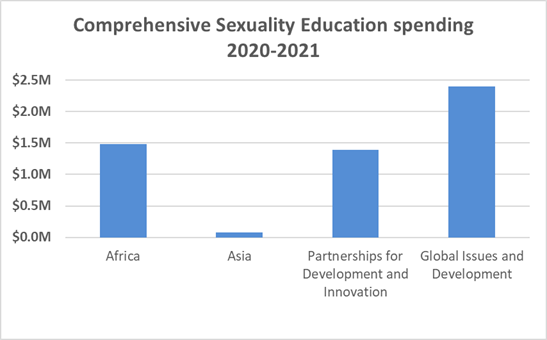
Text version
- Partnerships for Development and Innovation: $1.4M
- Global Issues and Development: $2.4M
- Asia: $0.1M
- Africa: $1.5M
SRHR neglected area 3: Safe abortion services and post-abortion care
The WHO defines comprehensive abortion care as “the provision of information, abortion management (including induced abortion and care related to pregnancy loss), and post-abortion careFootnote 4”. Canada works with a range of multilateral, government and non-government partners, particularly women’s rights organizations (WROs), to assist with:
- developing standards and guidelines for comprehensive abortion care that align with local policies for health providers
- advocating for legislative change to provide or expand abortion rights and access, and supporting WROs and other partners in these efforts
- working with local organizations to ensure that people understand their abortion rights and where they can receive relevant services, as well as to help shift discriminatory social norms that limit women’s and girls’ control over their bodies and SRHR-related decision-making
- training for healthcare workers in comprehensive abortion and post-abortion care
- increasing access to information about and access to medical abortion (also referred to as self-care)
In fiscal year 2020–2021, our investments in SRHR safe abortion and post-abortion care services reached $1.9 million.
SRHR neglected area 4: Family planning
According to the WHO, family planning comprises information, means and methods that allow people to attain their desired number of children and determine the spacing of their pregnancies.
In fiscal year 2020–2021, Canada’s investments in family planning reached $49 million. For example, our 2020–2021 contributions to the Health Pooled Fund in South Sudan supported the provision of outpatient consultations to more than 6.13 million people, including 2.4 million children under the age of five. Our support to South Sudan also enabled over 82,000 women to deliver their babies at health facilities with the assistance of skilled birth attendants and provided over 80,000 individuals access to modern family-planning methods. In addition, our funding to UNFPA in fiscal year 2020–2021 helped avert almost 10 million unintended pregnancies, prevented 3.5 million abortions and saved the lives of 26,000 women in over 55 countries.
In addition to family planning programming, Canada’s engagement in platforms and with partners such as the Ouagadougou Partnership, Family Planning 2030 and UNFPA Supplies were critical to supporting family-planning efforts and coordination among government, civil society and donors.
The Ouagadougou Partnership (OP)Footnote 5 has made considerable gains between 2011 and 2021. For example, the OP successfully reached 6.5 million additional people with modern contraceptives in the nine West African countries. This surpassed its previous objective of increasing the number of users of family-planning services by at least 2.2 million by 2020. During its next phase (Beyond2020 Strategy), which runs until 2030 and aligns with FP2030, the OP will focus on engaging youth, fostering efforts to change social norms, supporting shared priorities in the region, and addressing the needs of individual countries.
10YC fiscal year 2020–2021 portfolio analysis
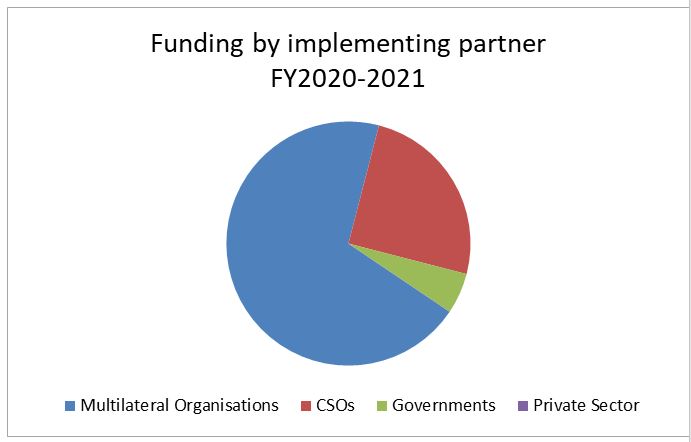
Text version
In fiscal year 2020–2021, the 10YC was implemented by a combination of:
- multilateral organizations (69.6%)
- CSOs (25%)
- governments (5.4%)
- private sector actors (0.02%)
Canadian CSOs delivered 19.5% of global health investments of the 10YC portfolio. In terms of the SRHR programming, Canadian CSOs delivered 18.8%.
A regional breakdown of global health investments, below, show that the majority of both bilateral and multilateral investments were directed to the Sub-Saharan Africa region (63.9%). This contributes to the FIAP target of directing 50% all Canada’s bilateral international assistance to the region. Seven of the ten countries receiving the most Canadian international assistance in fiscal year 2020–2021 were in Africa; the others were Bangladesh, Afghanistan and Pakistan.
Top Ten recipient countries in FY2020–2021
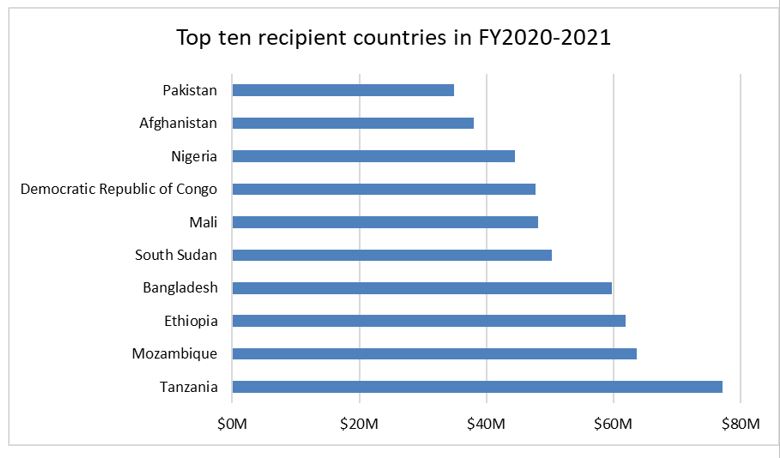
Text version
- Tanzania: $77.2M
- Mozambique: $63.7M
- Ethiopia: $62.0M
- Bangladesh: $59.7M
- South Sudan: $50.4M
- Mali: $48.2M
- Democratic Republic of Congo: $47.8M
- Nigeria: $44.5M
- Afghanistan: $38.0M
- Pakistan: $35.0M
In fiscal year 2020–2021, the largest sectors supported within the 10YC portfolio were sexually transmitted disease (STD) control including HIV/AIDS (12.3%), infectious disease control (9.8%), and reproductive healthcare (8%). Within the four neglected SRHR areas, family planning and SRHR advocacy and reform received the highest investments. A complete breakdown of sectoral commitments is in the chart below.
FY20–21 Sectoral investments in global health and SRHR (percentage of the portfolio)
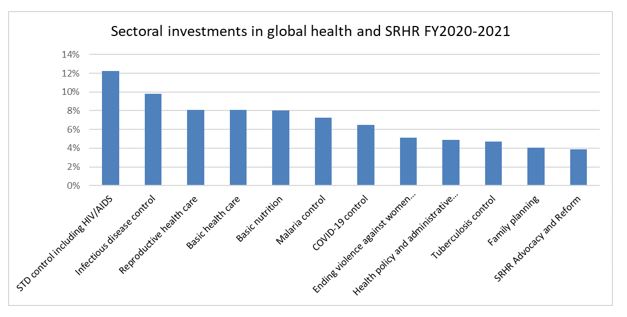
Text version
- STD control including HIV/AIDS: 12.26%
- Infectious disease control: 9.81%
- Reproductive health care: 8.07%
- Basic health care: 8.06%
- Basic nutrition: 8.02%
- Malaria control: 7.24%
- COVID-19 control: 6.50%
- Ending violence against women and girls: 5.13%
- Health policy and administrative management: 4.88%
- Tuberculosis control: 4.72%
- Family planning: 4.03%
- SRHR Advocacy and Reform: 3.88%
Performance, transparency, engagement & learning
As the primary channel for achieving the 10YC, GAC has also built its internal capacity, along with the capacity of external partners, by providing the tools and resources in support of the 10YC Accountability Framework. This contributes to:
- strengthening accountability and transparency of 10YC
- monitoring performance and evaluating 10YC outcomes
- using evidence to inform resource allocations and program management to optimize results.
Transparency, engagement and learning
Under the 10YC, GAC worked to improve the transparency of communication with stakeholders regarding our policies, investments and progress through public communications, online presence and stakeholder workshops.
GAC also launched the 10YC website, which provides background on the 10YC, presents spending data and features stories of change from our programming.
While the COVID-19 mobility restrictions and lockdowns significantly reduced our engagement with partners, GAC adapted by organizing virtual learning workshops to introduce the new 10YC Accountability Framework among a group of implementing partners who were starting to develop new global health and SRHR programming. This early engagement provided an opportunity to share monitoring and evaluation guidance, and strengthen 10YC reporting. GAC also hosted virtual dialogues with Canadian CSOs to discuss COVID-19 impacts on SRHR programming.
To strengthen accountability and transparency, in fiscal year 2020–2021, GAC developed coding guidance to help track investments made under the 10YC. This guidance, based on OECD DAC Sector Codes, ensures consistent coding across the Department, and helps to measure progress and to use evidence to course correct, when needed.
In addition, GAC developed new sector codes to track investments in:
- CSE
- safe and legal abortion and post-abortion care
- SRHR advocacy
- female genital mutilation/cutting
- child, early and forced marriage
As mentioned earlier, the new codes enabled us to establish a baseline of investments in SRHR-neglected areas for the first time and facilitates the tracking progress in future years.
GAC also developed a series of 10YC guidance materials for staff and management. These help explain our SRHR priorities and objectives, and ensure all GAC branches adopt a consistent, gender-transformative and high-quality approach to programming. The materials were developed in 2021, updated in spring 2022 and will be fully disseminated in the fall of 2022. An SRHR Toolkit and Guidance on Gender-Transformative Programming has also been developed and will be disseminated alongside the guidance notes. In addition, training in 10YC coding was delivered to staff in fiscal year 2020–2021, including orientation on GAC’s Health and Nutrition Key Performance Indicators, the newly released WHO Abortion Care Guideline and how to address opposition to SRHR, along with other topics.
Performance
To monitor the 10YC performance and evaluate outcomes, in 2020, GAC developed a new Logic Model and Results Framework for the Health and Nutrition Action Area of the FIAP. The Theory of Change of the 10YC is a conceptual framework structured around three intermediate outcomes. It incorporates health systems strengthening, determinants of health, social behaviour change, and rights-based health and women’s empowerment.
Health and nutrition logic model
- 1000 Enhanced equal enjoyment of health and health rights for those experiencing poverty, marginalization and/or vulnerability
- 1100 Increased use of gender responsive quality health services
- 1200 Improved healthy behaviours and practices that support women’s autonomy and decision making
- 1300 Strengthened equal protection and promotion of health rights by governments and key stakeholders
In addition, we developed a set of project-level Key Performance Level Indicators (KPIs) in fiscal year 2020–2021 as part of the Results Framework to measure performance of the 10YC in alignment with the three Health and Nutrition Action Area FIAP KPIs: health services, nutrition and SRHR. In fiscal year 2020–2021, in collaboration with implementing partners GAC successfully piloted a KPI performance management data system that resulted in high quality performance data. Forty-six Canadian, international and local partners, representing 62 projects participated. FY 2020/21 KPI data from these projects demonstrated the following:
- Health Services: A total of 3,667,720 people (3,352,405 female and 315,315 male) received improved basic health services in 21 countries. Partners trained 13,178 female and 6,155 male health care workers in basic health care across 2,483 health facilities.
- Nutrition: A total of 2,323,125 people (1,667,476 female and 564,647 male) people received improved nutrition services and programs in 16 countries. Partners trained 62,952 female and 15,962 male health care workers in nutrition across 972 health facilities.
- SRHR: A total of 4,502,606 people (3,892,036 female and 268,636 male) people received improved sexual and reproductive health services in 28 countries. As part of these services, partners also provided abortion and post-abortion care to 76,120 women in 17 countries. Partners trained 9,322 female and 3,282 male health care workers in sexual and reproductive health across 4,209 health facilities.
Based on the success of the KPI pilot, GAC will continue to collect project data from participating partners annually and report it to stakeholders.
Looking forward
The next phase of Canada’s leadership in global health and rights will focus on continuing to scale up funding for global health and improve the rights for all, especially for women and girls. This will contribute to meeting the $1.4 billion commitment by fiscal year 2023-2024, including $700 million per year for SRHR.
Achieving these objectives will require strong policy, programming and advocacy leadership. We will advance our policy objectives through global fora, such as the G7/G20 and the UN, advocating for strong SRHR and gender equality language and commitments. We will also continue to advocate with key international, regional and national stakeholders.
As Canada looks toward recovery from the COVID-19 pandemic and prevention, preparedness and response to future health emergencies, we will also work with partners such as the WHO to meaningfully integrate comprehensive and gender-transformative SRHR into health systems strengthening and universal health coverage (UHC). We will build upon commitments made within the SDGs and the 2019 UHC Political Declaration. As well, Canada will continue to support the important work of partners who are ensuring that quality SRH services continue to be available and accessible, and who are working to protect advocacy efforts that promote rights for all, especially women and girls in all their diversity.
Canada will also continue to support and prioritize programming that scales up attention to the SRHR neglected areas, including by partnering with Canadian health partners to improve the quality of and access to integrated health services by women, adolescents and children. Equally, Canada will maintain its engagement with global health platforms, such as Gavi, the GPEI, the GFF, and the GFATM, to support a strong COVID-19 recovery and to deliver long-term health objectives that focus on marginalized populations, and maintain health and SRH services.
Given the growing food security and malnutrition crisis, exacerbated by the ever-present climate crisis, the war in Ukraine and COVID-19, we will also work to better understand and address the intersections between climate, nutrition, food security, health, education and gender, and program accordingly. This will include support for multi-sectoral approaches that further Canada’s leadership in nutrition (i.e. strengthening gender-transformative food systems and supporting women’s economic empowerment in agriculture and food sectors).
Internally, GAC will continue to sensitize the 10YC among staff at all levels, with a focus on the SRHR-neglected areas. This will help ensure that investments in global health and SRHR are scaled up while also managing competing pressures. This sensitization includes providing relevant information and technical support to staff in our Embassies and High Commissions, as well as actively linking programming with policy and advocacy, both globally and at the country level. Additional work is also needed going forward to familiarize external partners with our coding guidance.
These combined efforts are key to preserving gains made and to prevent further backsliding of progress towards achieving the SDGs. We look forward to working with our partners in achieving these milestones for the year ahead.
- Date modified: